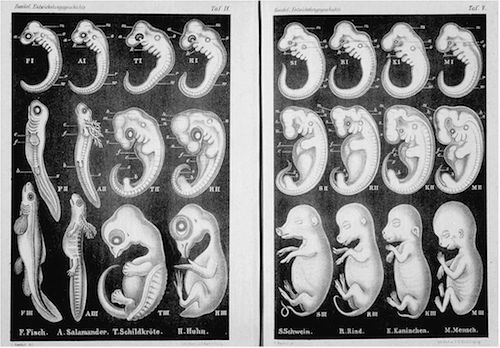 Education
Education
 Evolution
Evolution
Haeckel’s Fraudulent Embryo Drawings Are Still Present in Biology Textbooks — Here’s a List

Recently a colleague asked for a list of textbooks that use Ernst Haeckel’s fraudulent embryo drawings, which since the 19th century have been used to support the hypothesis of universal common ancestry. We’ve covered this many times over the years (see here, here, here, here, here, here, here, here, here, here, here, or here). Yet somehow we’ve never tried to gather into a single list many (or perhaps nearly all) known examples of textbooks in recent memory that use Haeckel’s drawings. Our colleague’s email provides an occasion for doing so.
Thus, what follows are examples of textbooks that
(1) Show embryo drawings that are either Haeckel’s originals or highly similar or near-identical versions of Haeckel’s illustrations — drawings that downplay and misrepresent the differences among early stages of vertebrate embryos;
(2) Have used these drawings as evidence for current evolutionary theory and not simply to provide some kind of historical context for evolutionary thinking;
(3) Have used their Haeckel-based drawings to overstate the actual similarities between early embryos, which is the key misrepresentation made by Haeckel, even if the textbooks do not completely endorse
Haeckel’s false “recapitulation” theory. They then cite these overstated similarities as still-valid evidence for common ancestry.
That having been said, here is the list:
- Donald Prothero, Bringing Fossils to Life: An Introduction to Paleobiology (Columbia University Press, 2013).
- Sylvia S. Mader, Jeffrey A. Isaacson, Kimberly G. Lyle-Ippolito, Andrew T. Storfer, Inquiry Into Life (13th ed., McGraw Hill, 2011).
- Peter H. Raven, George B. Johnson, Kenneth A. Mason, Jonathan B. Losos, and Susan R. Singer, Biology (9th ed., McGraw Hill, 2011).
- Adaptive Curriculum online curriculum submitted to Texas State Board of Education for adoption in 2011.
- Rice University online curriculum submitted to Texas State Board of Education for adoption in 2011.
- Sylvia S. Mader, Biology (McGraw Hill, 10th ed., 2010).
- Sylvia S. Mader, Biology (McGraw Hill 2007).
- BSCS Biology: A Human Approach (Kendall Hunt Publishing Company, 2006).
- National Geographic, Alton Biggs, Lucy Daniel, Edward Ortleb, Peter Rillero, Dinah Zike, Life Science (McGraw Hill, Glencoe, 2005).
Here are some slightly older ones:
- Donald Prothero, Bringing Fossils to Life: An Introduction to Paleobiology (McGraw-Hill, 2nd edition, 2003).
- Joseph Raver, Biology: Patterns and Processes of Life (J.M. Lebel, 2004, draft version presented to the Texas State Board of Education for approval in 2003).
- Cecie Starr and Ralph Taggart, Biology: The Unity and Diversity of Life (Wadsworth, 2004, draft version presented to the Texas State Board of Education in 2003).
- Peter H. Raven and George B. Johnson, Biology (6th ed, McGraw Hill, 2002).
- Michael Padilla et al., Focus on Life Science: California Edition (Prentice Hall, 2001).
- Holt Science and Technology: Life Science (Holt, Rinehart and Winston, 2001).
- Burton S. Guttman, Biology (McGraw Hill, 1999).
- Peter H. Raven and George B. Johnson, Biology (5th ed, McGraw Hill, 1999).
- Albert Towle, Modern Biology (Holt, Rinehart, and Winston, 1999).
- William D. Schraer and Herbert J. Stoltze, Biology: The Study of Life (7th ed, Prentice Hall, 1999).
- Cecie Starr and Ralph Taggart, Biology: The Unity and Diversity of Life (8th ed, Wadsworth, 1998).
- Douglas J. Futuyma, Evolutionary Biology (3rd ed, Sinauer, 1998).
- Kenneth R. Miller and Joseph Levine, Biology: The Living Science (Prentice Hall, 1998).
- Kenneth R. Miller and Joseph Levine, Biology (4th ed., Prentice Hall, 1998).
- Judith Goodenough, Robert A. Wallace, and Betty McGuire, Human Biology: Personal, Environmental, and Social Concerns, 582 (Harcourt College Publishers, 1998).
- Donald Prothero, Bringing Fossils to Life: An Introduction to Paleobiology (McGraw-Hill, 1st edition, 1998).
- Helene Curtis and N. Sue Barnes, Invitation to Biology (5th Ed., Worth Publishers, 1994).
- Donald Voet and Judith G. Voet, Biochemistry (2nd ed, John Wiley & Sons, 1995).
- Kenneth R. Miller and Joseph Levine, Biology (3rd ed., Prentice Hall, 1995).
- Robert H. Dott and Donald R. Prothero, Evolution of the Earth (Mcgraw-Hill Education, Fifth Edition, 1994).
- Bruce Alberts, et al., Molecular Biology of the Cell (3rd ed, Garland, 1994).
- Joseph S. Levin and Kenneth R. Miller, Biology: Discovering Life (D.C. Heath, 2nd ed., 1994).
- Joseph S. Levin and Kenneth R. Miller, Biology: Discovering Life (D.C. Heath, 1991).
- Kenneth R. Miller and Joseph Levine, Biology (1st ed., Prentice Hall, 1991).
- Scott F. Gilbert, Developmental Biology (3rd ed, Sinaeur, 1985).
- Scott F. Gilbert, Developmental Biology (2nd ed, Sinaeur, 1988).
- Scott F. Gilbert, Developmental Biology (1st ed, Sinaeur, 1985).
Honorable mention that’s not a textbook: Ernst Mayr, What Evolution Is (Basic Books, 2000).
There you have it. As you can see, these drawings are pervasive, continuing to misinform students as they’ve done for going on a century and a half.
And you might see a trend publication dates of the offending textbooks. There are still some very recent textbooks (i.e., 2005 or younger) that use Haeckel’s drawings, but most of the textbooks in our list predate the year 2000. Why is that? It’s because 2000 was the year that Jonathan Wells published his book Icons of Evolution which raised the public’s consciousness about inaccuracies in biology textbooks, especially the prevalence of Haeckel’s faked embryo drawings. While some textbooks continue to promote the inaccurate “icons,” Wells’s book has had a positive impact, reducing the number of textbooks that use the fraudulent drawings.
Unfortunately, as this textbook review published in 2011 makes clear, biology textbooks still have a long way to go when it comes to fixing the icons of evolution.
Image: Lithograph by J. G. Bach of Leipzig after drawings by Haeckel, from Anthropogenie published by Engelmann [Public domain], via Wikimedia Commons.
